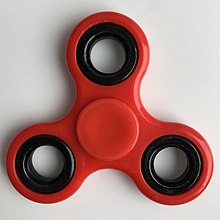A fidget spinner is a toy that consists of a ball bearing in the center of a multi-lobed (typically three-lobed) flat structure made from metal or plastic with metal weights in the lobes, designed to spin around its central axis. Fidget spinners became very prevalent trending toys in 2017.
 A typical three-lobed fidget spinner | |
| Type | Stress-relieving toy |
|---|---|
| Inventor(s) | Scott McCoskery |
| Country | USA |
| Availability | 2014–present |
| Materials | Brass, stainless steel, titanium, copper, plastic, etc. |

The toy has been promoted as helping people who have trouble focusing or those who may need to fidget to relieve nervous energy, anxiety, or psychological stress. There are claims that a fidget spinner can help calm down people who have neuro-developmental or mental disorders, such as ADHD and autism,[1] though peer-reviewed studies for this notion are lacking.[2][3][4]
A fidget spinner consists of a round, flat central bearing (usually a ball bearing) that allows the arms connected to it to rotate; around this central axis, there are usually three weighted arms, but their number varies depending on the model. When spun forcefully, they can continue spinning for up to several minutes, depending on the model.[5]
Development
In an interview appearing on May 4, 2017, on NPR, Scott McCoskery described how he created a metal spinning device called a "Torqbar"[6][7] around 2014 to satisfy with his own tendency to fidget in meetings and on conference calls while working in the information technology field in the Seattle, Washington, area of the United States.[8] He said he believed it was the first fidget spinner as they became known in their popular form.[6] In response to requests from an online community, he began selling the device online.[8]
Popularity and usage

With the rapid increase in the popularity of fidget spinners in 2017, many children and teenagers began using them in school, and some schools also reported that students were trading and selling the spinner toys.[9][10][11]
As a result of their frequent use by children at school, many school districts in the U.S. prohibited the toy.[12][13] Some teachers argued that the spinners distracted students from their schoolwork.[9] According to a survey conducted by Alexi Roy and published in May 2017, 32% of the largest 200 American public and private high schools had banned spinners on campus.[14]
When fidget spinners rose in popularity in 2017, many publications in the popular press discussed the marketing claims made about them for people with ADHD, autism, or anxiety.[4][12][13] However, there has not been research proving this notion.[3][4][15] They quickly fell in popularity and sales after peaking in May 2017.[16]
Invention and patent status
On May 11, 2016, Michael Scott McCoskery filed a provisional patent application for a utility patent on a version of the toy featuring a centrally mounted ball bearing and other specific design elements. His application included illustrations depicting two- and three-lobed versions of the toy. Following the submission of a final patent application in May 2017, McCoskery was granted a U.S. patent in March 2018.[17][18]
On November 29, 2016, David Allen Pavelsky of Killeen, Texas, applied for a design patent covering a three-lobed version of the toy with a centrally mounted ball bearing. Unlike McCoskery's patent, Pavelsky's application did not claim functional innovation, but rather focused on the toy's aesthetic design. He was granted a design patent in October 2017.[19]
By May 2017, the patent for fidget spinners had not yet been granted, despite growing market demand.[20] Catherine Hettinger, a chemical engineer, was incorrectly credited by some media outlets as the inventor of the fidget spinner, with reports from publications such as Money,[21] The Guardian,[12] The New York Times,[13] and the New York Post.[22]
Hettinger had filed a patent application for a "spinning toy" in May 1993. Her invention more closely resembled some sort of "finger frisbee" or a "finger hat". The patent was issued to her in January 1997.[23] However, she allowed the patent to lapse in 2005 after failing to find a commercial partner to manufacture the toy.[20][12] Even if her patent had not lapsed, it would have expired in January 2014, prior to the rise in popularity of fidget spinners.[23] Additionally, a May 2017 Bloomberg News article clarified that Hettinger had not invented the modern fidget spinner, as her design lacked the central bearing that allows the toy to be held and spun in place—an essential feature of today’s spinners.[20]
See also
- Fidget Cube
- Office toy
- Stress ball
- Top
- Worry stone
- Pet Rock
- Pop it, a 2021 fidget toy
References
External links
Wikiwand in your browser!
Seamless Wikipedia browsing. On steroids.
Every time you click a link to Wikipedia, Wiktionary or Wikiquote in your browser's search results, it will show the modern Wikiwand interface.
Wikiwand extension is a five stars, simple, with minimum permission required to keep your browsing private, safe and transparent.
